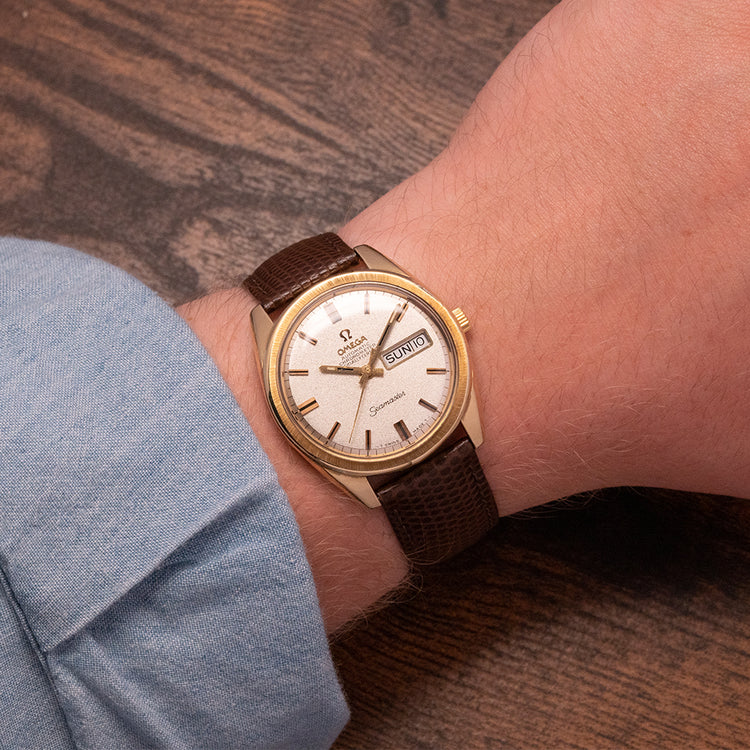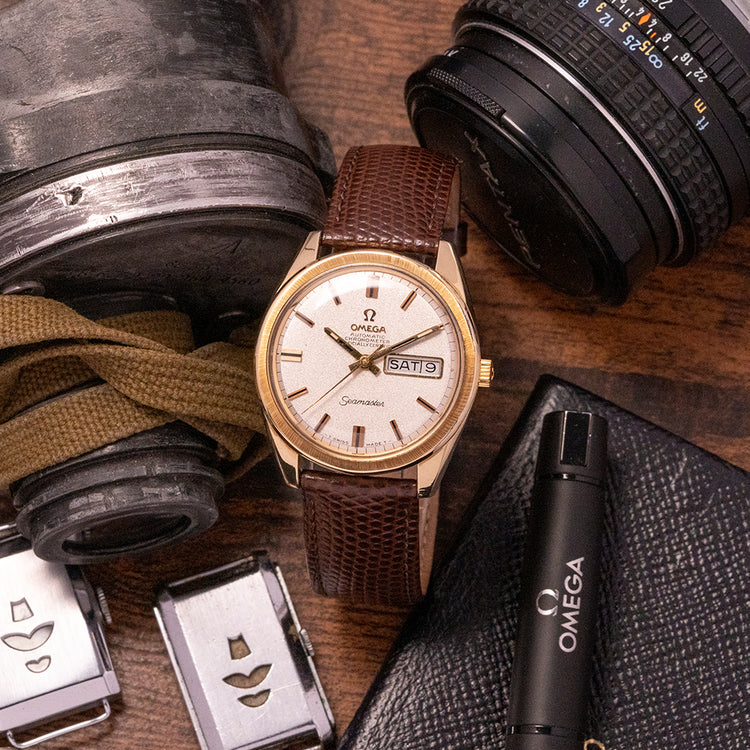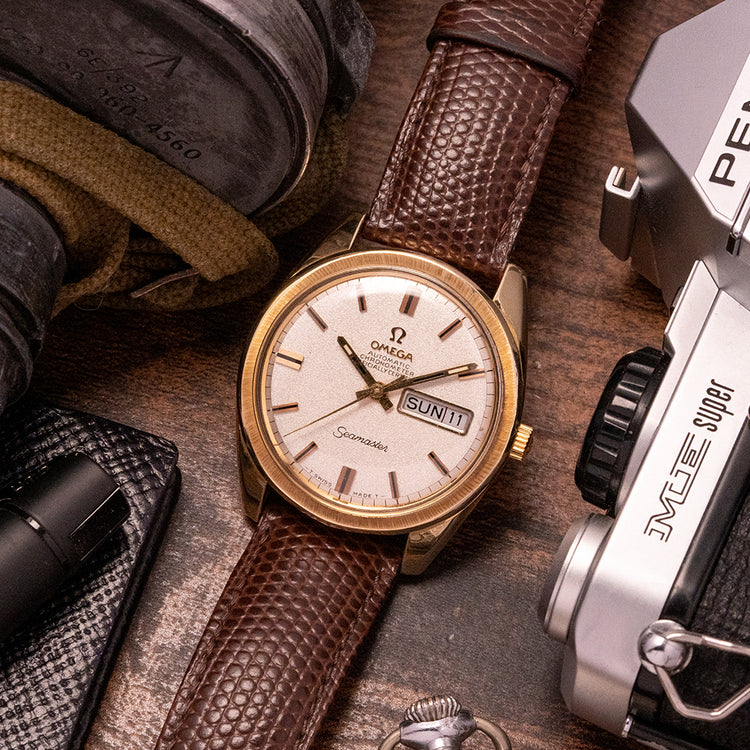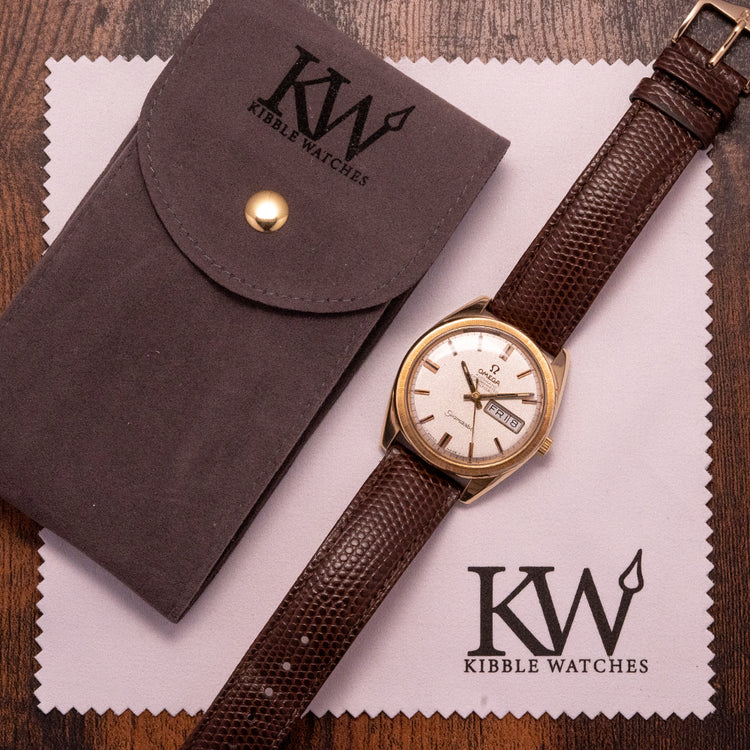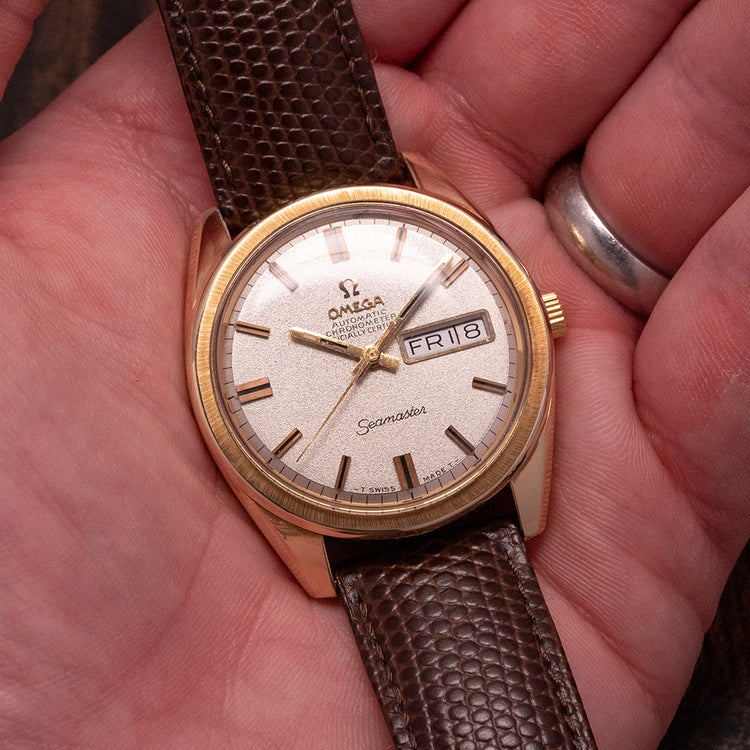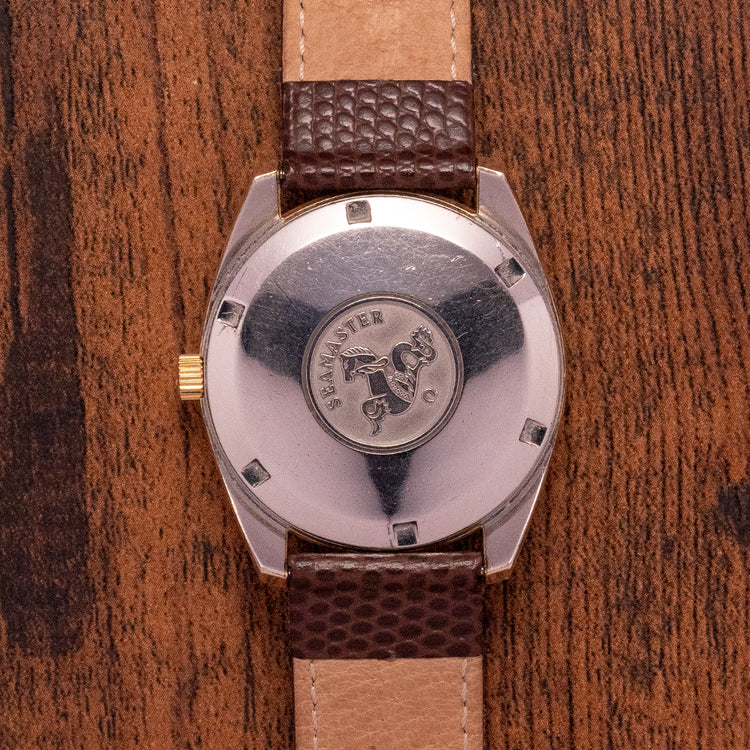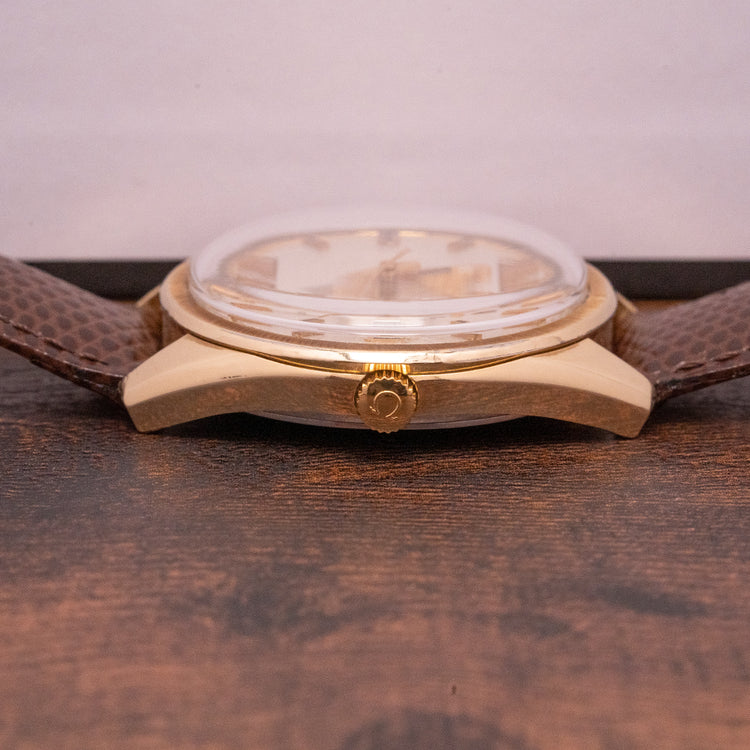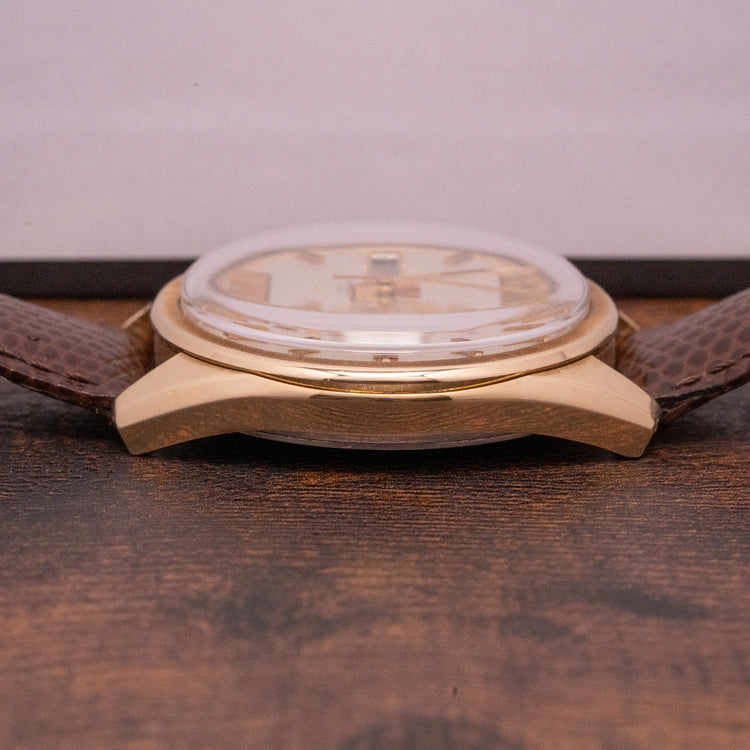More Information
Description
More
Less
The Watch
Here we have a 1968 Omega Seamaster "Chronometer" 166.032 with a curvaceous 36mm, yellow gold plated case, a lug-to-lug length of 41.5mm with gently curved tapered thick lugs and a case thickness of 11.5mm ensures a comfortable fit on your wrist. The gold surfaces catch the light and shimmer as you rotate your wrist. On the right side, is a signed push/pull crown. A smooth bezel has polished sides and a radial brushed top surface that holds the domed crystal above a stunning silver textured dial with an outer minute track and chamfered applied baton indexes, onyx-filled centres marking the hours. At 3 o’clock a framed day/date window, and gold-plated sword hands have onyx and luminance filling complemented by a tapered centre second hand completes the attractive dial, text is precisely printed at 12 o’clock with an applied gold-plated Omega motif and 6 o’clock “Seamaster”. On the screw-down case back we have the embossed hippocampus, a seahorse on the case back that represents Neptune the god of the sea, it was conceived by Pierre Borie after seeing a picture of Neptune riding a chariot pulled by seahorses, it is the reason why the seahorses are wearing a bridle and first seen on the Seamaster in 1958. Inside an automatic Omega Cal. 751, 24 jewels, 19,800 beats per hour and the watch comes paired with a 19mm Hirsch leather strap.
Points of Mention
This watch is sold as "Watch Only" and therefore comes with no original Omega box or paperwork. The watch comes paired with a well-suited 19mm Hirsch leather strap. The watch is from Circa. 1968 and is sold in worn, vintage condition, as you can see from the photographs. The watch comes with our 12-Months Non-Waterproof Warranty.
For more photos see here - https://drive.google.com/drive/folders/17I51QzYCai9kjH_SF7-66S2CZOHolYTo?usp=drive_link
4K YouTube video, skip to 17:07 - https://youtu.be/KKgfz8w73jo
Personal Note
We have had the privilege of selling the 18ct solid gold reference 168.022 and it has to have been one of the most shared Omega Seamasters we have stocked, obviously being full 18ct gold it was a fair bit pricier than this incredible gold plated reference, plus that had a spun dial whereas this has a beautifully textured dial. I wouldn't hesitate on this one if you are after a great-looking gold-tone Seamaster that doesn't break the bank!
Specification
Lugs : 19mm
Condition : Pre-Owned
Box & Papers : None
Case Material : Gold Plated
Warranty : 12-Months Non-waterproof Warranty
The Brand
They were formerly known as the La Generale Watch Co. in 1848 founded by Louis Brandt in La Chaux-de-Fonds. When he died in 1879, his sons carried on his dream. In 1880 they moved to 96 Rue Jakob-Stampfli where they remain today. The brothers produced their first mass-produced calibre, the Labrador In 1885. Just a few years later in 1892, they produced the first minute-repeater. In 1903 they renamed the company Omega until 1982 when they officially changed their name to Omega SA. During WW1 Omega watches were used as official timekeepers for the Royal Flying Corps and the US Army. In 1930, Omega and Tissot merged together to form Société Suisse pour l'Industrie Horlogère (SSIH) In 1931, another group was formed - Allgemeine Schweizerische Uhrenindustrie AG (ASUAG). Where SSIH was primarily French-speaking, ASUAG was founded by the more German-speaking members of the Swiss watch industry. In 1948 they introduced the first edition of one of its most symbolic watches: the Seamaster. Omega first introduced the Constellation in 1952. At the time it was Omega's flagship timepiece. The first models had a Cal. 354 bumper movement in them. Later in 1955, Omega introduced the Automatic Cal. 50x, followed in 1959 by the Cal.55x (no date) and 56x (date) versions. Many of the Constellations came with pie-pan dials, diamond indexes, and fancy lug configurations. All the gold Constellations of that time have the Observatory of Geneva's hand engraved on the back. The stainless steel and stainless steel/gold versions had a gold medallion on the back with the Observatory of Geneva. The eight stars above the Observatory stand for the many exploits of Omega in the world Chronometer competition. Celebrating the fact that all Constellations are Chronometer Certified. In 1962, when astronaut Wally Schirra wore a Speedmaster on his Mercury Sigma 7 Mission, making it the first Omega watch to enter space. After rigorous tests, NASA used Omega for all their Apollo missions including the 1969 Moon landing of Apollo 11. Today Omega is still an astronaut's first choice. In 1969, President Nixon famously said it was “too valuable” and turned down the first-ever all-gold Speedmaster Professional Deluxe. As a response to the ever-growing threat of electronic watches to the manufacturers of mechanical watches, Omega and many Swiss brands such as Rolex and Patek Philippe formed Centre Electronique Horologer (CEH). Prototypes began to appear in 1967 with their production starting in 1968. Then In 1972, Omega introduced the reference, 198.030, which included the Omega calibre 1250, a ‘tuning-fork electronic movement which was made under licence from Bulova. Later we saw a merger of SSIH and ASUAG into SMH, or Société de Microélectronique et d’Horlogerie. This merger took place in 1983. In 1992, the company acquired Blancpain, and in 1998 it officially rebranded itself from SMH to the Swatch Group. Then, in 1999, they purchased and integrated Breguet into the Swatch Group.
Points of Mention
More
Less
Personal Note
More
Less
Specification
More
Less
Movement : Automatic Omega Cal. 751
Year : 1968
Case Size : 36mm
Case Thickness : 11.5 mm
Lug to Lug : 41.5mm
Lugs : 19mm
Condition : Pre-Owned
Box and Papers : None
Case Material : Gold Plated
Warranty : 12-Months Non-waterproof Warranty
The wrist model's wrist size is 7inch
About Omega
More
Less
Description
The Watch
Here we have a 1968 Omega Seamaster "Chronometer" 166.032 with a curvaceous 36mm, yellow gold plated case, a lug-to-lug length of 41.5mm with gently curved tapered thick lugs and a case thickness of 11.5mm ensures a comfortable fit on your wrist. The gold surfaces catch the light and shimmer as you rotate your wrist. On the right side, is a signed push/pull crown. A smooth bezel has polished sides and a radial brushed top surface that holds the domed crystal above a stunning silver textured dial with an outer minute track and chamfered applied baton indexes, onyx-filled centres marking the hours. At 3 o’clock a framed day/date window, and gold-plated sword hands have onyx and luminance filling complemented by a tapered centre second hand completes the attractive dial, text is precisely printed at 12 o’clock with an applied gold-plated Omega motif and 6 o’clock “Seamaster”. On the screw-down case back we have the embossed hippocampus, a seahorse on the case back that represents Neptune the god of the sea, it was conceived by Pierre Borie after seeing a picture of Neptune riding a chariot pulled by seahorses, it is the reason why the seahorses are wearing a bridle and first seen on the Seamaster in 1958. Inside an automatic Omega Cal. 751, 24 jewels, 19,800 beats per hour and the watch comes paired with a 19mm Hirsch leather strap.
Points of Mention
This watch is sold as "Watch Only" and therefore comes with no original Omega box or paperwork. The watch comes paired with a well-suited 19mm Hirsch leather strap. The watch is from Circa. 1968 and is sold in worn, vintage condition, as you can see from the photographs. The watch comes with our 12-Months Non-Waterproof Warranty.
For more photos see here - https://drive.google.com/drive/folders/17I51QzYCai9kjH_SF7-66S2CZOHolYTo?usp=drive_link
4K YouTube video, skip to 17:07 - https://youtu.be/KKgfz8w73jo
Personal Note
We have had the privilege of selling the 18ct solid gold reference 168.022 and it has to have been one of the most shared Omega Seamasters we have stocked, obviously being full 18ct gold it was a fair bit pricier than this incredible gold plated reference, plus that had a spun dial whereas this has a beautifully textured dial. I wouldn't hesitate on this one if you are after a great-looking gold-tone Seamaster that doesn't break the bank!
Specification
Lugs : 19mm
Condition : Pre-Owned
Box & Papers : None
Case Material : Gold Plated
Warranty : 12-Months Non-waterproof Warranty
The Brand
They were formerly known as the La Generale Watch Co. in 1848 founded by Louis Brandt in La Chaux-de-Fonds. When he died in 1879, his sons carried on his dream. In 1880 they moved to 96 Rue Jakob-Stampfli where they remain today. The brothers produced their first mass-produced calibre, the Labrador In 1885. Just a few years later in 1892, they produced the first minute-repeater. In 1903 they renamed the company Omega until 1982 when they officially changed their name to Omega SA. During WW1 Omega watches were used as official timekeepers for the Royal Flying Corps and the US Army. In 1930, Omega and Tissot merged together to form Société Suisse pour l'Industrie Horlogère (SSIH) In 1931, another group was formed - Allgemeine Schweizerische Uhrenindustrie AG (ASUAG). Where SSIH was primarily French-speaking, ASUAG was founded by the more German-speaking members of the Swiss watch industry. In 1948 they introduced the first edition of one of its most symbolic watches: the Seamaster. Omega first introduced the Constellation in 1952. At the time it was Omega's flagship timepiece. The first models had a Cal. 354 bumper movement in them. Later in 1955, Omega introduced the Automatic Cal. 50x, followed in 1959 by the Cal.55x (no date) and 56x (date) versions. Many of the Constellations came with pie-pan dials, diamond indexes, and fancy lug configurations. All the gold Constellations of that time have the Observatory of Geneva's hand engraved on the back. The stainless steel and stainless steel/gold versions had a gold medallion on the back with the Observatory of Geneva. The eight stars above the Observatory stand for the many exploits of Omega in the world Chronometer competition. Celebrating the fact that all Constellations are Chronometer Certified. In 1962, when astronaut Wally Schirra wore a Speedmaster on his Mercury Sigma 7 Mission, making it the first Omega watch to enter space. After rigorous tests, NASA used Omega for all their Apollo missions including the 1969 Moon landing of Apollo 11. Today Omega is still an astronaut's first choice. In 1969, President Nixon famously said it was “too valuable” and turned down the first-ever all-gold Speedmaster Professional Deluxe. As a response to the ever-growing threat of electronic watches to the manufacturers of mechanical watches, Omega and many Swiss brands such as Rolex and Patek Philippe formed Centre Electronique Horologer (CEH). Prototypes began to appear in 1967 with their production starting in 1968. Then In 1972, Omega introduced the reference, 198.030, which included the Omega calibre 1250, a ‘tuning-fork electronic movement which was made under licence from Bulova. Later we saw a merger of SSIH and ASUAG into SMH, or Société de Microélectronique et d’Horlogerie. This merger took place in 1983. In 1992, the company acquired Blancpain, and in 1998 it officially rebranded itself from SMH to the Swatch Group. Then, in 1999, they purchased and integrated Breguet into the Swatch Group.
Points of Mention
Personal Note
Specification
The Brand
Enquire or Book an Appointment
Would you like to discover further details about this watch, or perhaps arrange an appointment to view and try it on? Complete this form and a member of our team will get back to you shortly.
You May Also Like





















